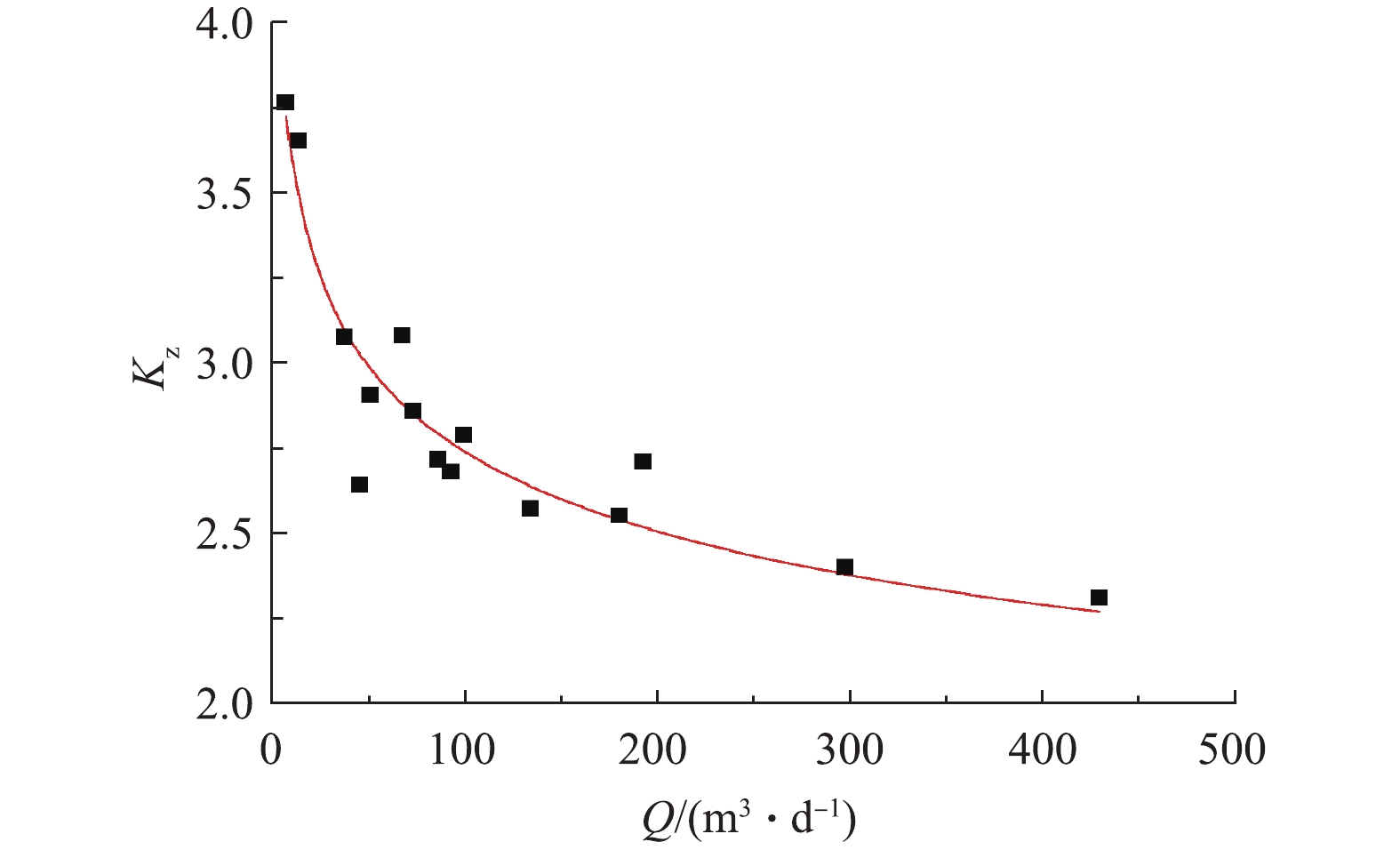-
由于我国农村地区环境污染治理力度不足和缺乏有限的监管,造成了农村环境污染问题的凸显[1-2]。目前,农村地区居民生活污水仍缺少适当处理,而农村地区居民生活污水治理的完善程度是农村社会发展和农民福利改善的制约因素。
在建设农村地区居民污水治理工程的过程中发现,农村地区居民生活污水的水量和水质波动范围较大。日变化受村庄人口作息时间和迁出迁入的影响,早/中/晚3个高峰时段污水量大,其它时段污水量小;工作日水量小,节假日水量大。特别是在采用自然渠(沟)收集污水的村庄,受气候和季节影响明显,冬季水量小、污染浓度较高;夏季水量大、污染浓度较低。另外,旅游区和农家乐对污水水量变化影响较大,旺季水量较大,淡季水量较小。
污水量总变化系数大小与设计规模(Q)呈负相关[3],农村生活污水处理设施的设计规模较小(一般≤432 m3·d−1),故农村污水量总变化系数较大。现行城镇污水处理规范中并未给出适用于农村小规模污水处理设施的变化系数取用的指导。同时,由于中外农村经济发展和生活习惯存在较大的差距,在此领域亦无适合的国外经验可供参考。因此,确定我国农村居民生活污水量总变化系数已成为农村居民污水处理设施设计和运行维护的难点之一。本研究拟对现有国家和行业给水排水规范中关于污水量总变化系数的资料进行分析和总结;并根据北京市已建成的农村居民污水处理站水量监测数据,通过统计分析以获得农村居民生活污水量总变化系数。本研究结果可为制定农村居民生活污水处理设施的设计、建设与运行维护中确定污水量总变化系数提供参考。
全文HTML
-
污水量总变化系数定义为最大日最大时污水量与平均日平均时污水量的比值,总变化系数(Kz)可由式(1)获得。
式中:Kd为日变化系数;Kh为时变化系数。Kd和Kh分别由式(2)和式(3)获得。
式中:Cdm为最大日污水量,m3·d−1;Cda为平均日污水量,m3·d−1。
式中:Chm为最大日最大时污水量,m3·d−1;Cha为最大日平均时污水量,m3·d−1。
由式(1)~式(3)可知,只要获得最大日污水量、平均日污水量、最大日最大时污水量和最大日平均时污水量就可以计算得到总变化系数Kz的值。由于污水量具有时变化、日变化、季节变化和年变化的特点,故总变化系数获取至少需要1年或以上的逐日污水量的数值,并需要获得最大日污水量的逐时变化。在缺乏污水量1年或以上的逐日资料时,也可以根据用水量(供水量)的1年或1年以上的逐日水量和最大日用水量资料来估算总变化系数。这种方法是建立在“生活污水量=用水量×污水排放系数”的基础上,在假设污水排放系数为常数时,污水量时变化系数、日变化系数和总变化系数分别等于用水量时变化系数、日变化系数和总变化系数。
-
为了获得农村生活污水处理站污水量总变化系数随处理规模的变化,本研究选择企业用水量比例低或无企业用水和全日供水的北京市通州区14个农村生活污水处理站进行了进水水量跟踪测定。测定时间为2018年4月至2019年3月,记录每小时的流量。测量采用分体式超声波流量计(测量范围:0~50 m3·h−1;测量精度:0.5级)。通过1年典型日的污水量测定资料获得最大日污水量和平均日污水量,从而获得14个站的日变变化系数Kd值;通过最大日各个时段的污水量测定资料获得最大日最大时污水量和最大日平均时污水量,获得时变化系数Kh值;再根据各站的Kd和Kh值计算获得各站的总变化系数Kz值。
1.1. 污水量总变化系数获取方法
1.2. 实际工程总变化系数测定
-
根据既有工程经验的分析总结,在我国相关现有给水排水设计规范中直接给出了变化系数的数值,以便工程设计中直接使用。对现有的给水排水设计规范进行了整理分析,发现目前涉及到污水量变化系数的规范有《室外排水设计规范》[4]和《镇(乡)村排水工程技术规程》[5];涉及到用水量时变化系数、日变化系数的有《室外给水设计规范》[6]、《镇(乡)村给水工程技术规程》[7]和《村镇供水工程设计规范》[8]。
目前,我国城镇污水处理厂工程设计中基本上直接使用《室外排水设计规范》[4]确定Kz值(见表1)。表1中Kz值是基于我国早期分流制排水系统还不完善情况下研究成果获得的。因此,在规范中特别提示,对于新建分流制排水系统的地区,以及既有地区进行排水系统分流制改造工程后,宜提高综合生活污水量总变化系数。这说明,在分流制地区综合生活污水量总变化系数Kz值应大于表1数值。当污水平均日流量为中间数值时,总变化系数Kz值可用内插法求得。但该规范中仅给出设计规模≥432 m3·d−1的Kz值,对于农村生活污水处理工程通常设计规模<432 m3·d−1的Kz值则无法根据表1获得。
在《镇(乡)村排水工程技术规程》[5]中给出的综合生活污水量总变化系数如表2所示。对比分析表2和表1可知,对于规模在3 456~6 048 m3·d−1的,表2中总变化系数比表1中大0.1;规模在3 456 m3·d−1以下的,表2中总变化系数比表1中大0.2;规模在≥8 640 m3·d−1的,表2与表1中总变化系数相同。由此可知,在《镇(乡)村排水工程技术规程》[5]中对于设计规模较小污水处理站的总变化系数数值稍有增加。但是,在该规范中仍不能获得对于农村生活污水处理工程设计规模<432 m3·d−1的Kz值。
《室外给水设计规范》[6]明确指出,城镇供水的时变化系数、日变化系数应根据城镇性质和规模、国民经济和社会发展、供水系统布局,结合现状供水曲线和日用水变化分析确定;在缺乏实际用水资料情况下,最高日城市综合用水时变化系数宜采用1.2~1.6、日变化系数宜采用1.1~1.5。假设污水排放系数为常数,则由此可得到总变化系数Kz=1.32~2.4,与《室外排水设计规范》[4]中的总变化系数(Kz=1.3~2.3)取值接近。因此,以上述方法获得的污水量总变化系数Kz值只适用于城镇污水处理工程(污水处理规模≥432 m3·d−1),不适用于农村污水污水处理工程(污水处理规模<432 m3·d−1)。
在《镇(乡)村给水工程技术规程》[7]和《村镇供水工程技术规范》[8]中给出的日变化系数为1.3~1.6;无企业用水量或企业用水量比例较低时的全日供水工程的时变化系数为2.0~3.0,由此可以获得生活污水量总变化系数值为2.6~4.8。在《镇(乡)村给水工程技术规程》[7]定时供水工程的时变化系数为3.0~5.0,对应条件下的生活污水量总变化系数值为3.9~8.0。在《村镇供水工程技术规范》[8]定时供水工程的时变化系数为3.0~4.0,对应条件下的生活污水量总变化系数值为3.9~6.4。由此可见,村镇乡污水量总变化系数Kz远大于城镇污水量规模下的总变化系数,符合总变化系数与污水规模之间的逻辑关系。
根据以上给水排水现有规范中关于总变化系数的分析可知,在目前相关排水设计规范中,采用直接给出总变化系数的方法。在《室外排水设计规范》[4]和《镇(乡)村排水工程技术规程》[5]中,缺少适合于农村污水处理规模(<432 m3·d−1)的总变化系数值;在目前相关给水设计规范中均采用给出供水日变化系数和时变化系数的方法,但仅仅给出变化范围,没有给出变化系数随规模大小之间的变化规律。因此,在污水排放系数不变的假设下,也只能获得总变化系数的取值范围,不能获得直接的总变化系数数值。所以,在实际农村污水处理工程中,农村生活污水量总变化系数仍很难根据现有的规范来确定。这将影响农村生活污水量及污水处理站建设规模的最终确定,影响农村污水处理设施构筑物的工程设计,从而影响建成后的运行效果。因此,仍需进一步对农村生活污水量总变化系数进行研究。
-
2018年4月至2019年3月间,本研究对北京市通州区14个农村生活污水处理站进行了进水水量跟踪测定。根据测量资料,首先,通过1年典型日的污水量测定资料获得最大日污水量和平均日污水量,从而获得14个站的日变变化系数Kd值为1.31与1.95;然后,通过最大日各个时段的污水量测定资料获得最大日最大时污水量和最大日平均时污水量,从而获得时变化系数Kh值为1.35与2.22;最后根据各站的Kd和Kh值计算获得各站的总变化系数Kz值(见图1)。在图1中同时给出《室外排水设计规范》[4]中的最小污水量432 m3·d−1时的Kz值为2.3。
根据图1中14个污水站及《室外排水设计规范》[4]中的最小污水量432 m3·d−1时的污水量总变化系数Kz值,以污水量Q为自变量,以总变化系数作为因变量,通过回归分析,获得总变化系数Kz值与污水量(处理规模)的经验关系,其经验公式见式(4)。
其决定系数R2=0.87,即Kz趋势线与研究分析所得实际点绘图匹配度达到87%。使用式(4)估算的14站点的总变化系数值与实测值之间最大绝对误差为0.38,最大相对误差为14.00%。因此,在实际工程应用中,可以根据式(4)来估算企业用水量比例低或无企业用水和全日供水情况下的总变化系数Kz值(见表3),并以此指导实际工程中农村生活污水量及污水处理站建设规模的最终确定。
北京市“新农村污水综合治理示范工程”课题组[9]对2008年和2009年北京市10个区县78个农村污水处理站进行水量变化监测,其中对13个站进行连续2年的进水量变化跟踪测定,65个站进行了夏季周末的测定。研究结果表明:村庄生活污水量日变化系数Kd为1.3~2.4、时变化系数Kh为2.0~2.6、总变化系数Kz为2.5~6.2。该课题研究结果与本研究表3中的理论计算结果基本相符。
2.1. 现有设计规范中的生活污水量变化系数
2.2. 实际工程测定的总变化系数
-
1)在目前相关排水设计规范中均采用直接给出总变化系数或范围的方法,然而缺少适合于农村污水处理规模(<432 m3·d−1)的总变化系数值;在实际农村污水处理工程中,农村生活污水量总变化系数仍很难根据现有的规范来确定。
2)在企业用水量比例低或无企业用水和全日供水情况下,当农村生活污水日处理规模为1~400 m3·d−1时,污水量总变化系数(Kz)可取值为2.28~5。




 下载:
下载:






